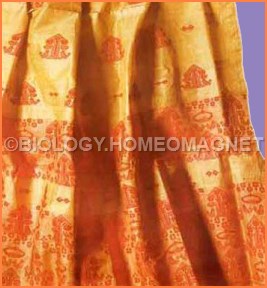Zoology Related Pages:
- Zoology
- Animal Kingdom Classification
- Beginning of Life
- Animal Diversity
- Apiculture
- Fishery
- Capture Fisheries
- Culture Fishery
- Fish breeding
- Induced Breeding
- Composite Fish Culture
- Carp Disease
- Prawn Culture
- Brackish-Water Prawn Culture
- Sericulture
- Silkworm Diseases
- Mulberry Tree
- Cultured Pearls
- Poultry Farming
- Poultry Feed
- Rat Problem
- Rat Control
- Medical Zoology
- Life Cycle of Mosquito
- Roundworm
- Tapeworm
- Stem Borer
- Rice Bugs
- Protozoa
- Porifera
- Cindaria
- Ctenophora
- Nematoda
- Epithelial Tissue
- Types of Epithelial Tissue
- Connective Tissue
What is sericulture?
Cloth is a vital need of social human beings. From the early part of civilisation, the human beings started to prepare clothes from the natural fibres. Plants and animals are the natural resources from which the fibbers are collected. In animals there are certain insects that secrete a substance from which the fibres are extracted and used for the manufacture of cloth. The Larva, a stage in the life history of an insect secret a substance from their own gland and there secretion forms a covering their body for their own protection. This covering is called cocoon. Various kinds of fibres are extracted by man from the different nature of cocoon and are commonly known as silk. The extraction and processing of silk fibres had led to the development of Sericulture.
The scientific process of rearing the larvae of silkworm for production of the cocoon and the extraction of good quality of fibres from these cocoons is known as sericulture. Properly the sericulture deals with the mulberry cultivation, rearing of silkworms, production of cocoons, extraction and reeling of silk fibres.
Distribution of Sericulture: -
The countries producing the most of the silk of the world are Japan, China, Russia, Korea and India. But sizeable quantities of silk are also produced by Italy, Bulgaria, Brazil, Iran, Turkey, Thailand, Rumania, Spain, Greece, Hungary and many other countries.
What is the economic importance of Sericulture?
In modern ages, though different types of synthetic fibres have been developed yet the demand of silk is steadily increasing and continuous to reign in supreme. Sericulture is essentially a village-based industry and it has been practised even today mainly by the small and medium-sized landholders as a subsidiary occupation. The recent technological development have made it possible to practice sericulture on an intensive scale, and for this reason it has become more remunerative than most of the agricultural crops. So the silk also plays an important role for economic development of the country.
What is the definition of silk?
The silk may be defined as a kind of glossy thread which is obtained from this sick creation of silk gland coming out through the spinneret and mouth of matured silkworm.
What is the chemical composition of silk?
Two types of protein namely fibroin and sericin by which the silk is composed of. The Centre of the fibre is formed by fibroin is called the inner core and the sericin covers the fibroin on the outer side. 75 to 80% of the fibre is formed by fibroin and the rest is formed by sericin. So the chemical composition of the silk is protein.
Colouration of silk: –
The covering of the silk fibre the sericin becomes coloured due to presence of pigments likexanthophyll and carotinoids. As the fibre is coloured so the cocoon also becomes coloured. Different types of silk fibres have defined colouration. There are four types of silk fibres and the colours of those fibres are as follows:
i) Mulberry or Chinese silk: the mulberry silk fibres are yellowish or greenish in colour. This type of silks are March shiny then other silk and commonly known as the pure silk.
ii) Eri silk: The eri or endi silkfibres are either creamy white or brick-red in colour. These types of silk are less shiny than the mulberries silk.
iii) Tasar silk: The fibres of tasar silkare copperish coloured.
iv) Muga silk: The muga silk fibres are golden in colour.
Qualities of silk: -
The fibres of silk are tough and bright but at the same time it is soft, light and elastic in nature. It never creates any reaction on the skin of human body and completely non allergic. The cloth made by silk is useable in all seasons. For these causes the silk is treated as queen of textiles even today.



